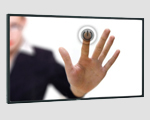Kids today have it all: the cell phone, the iPod, the iPad, the internet, digital cameras, video games, laptops – ahhh!!! With all this stimuli, teachers have to battle to win the ever-decreasing attention spans of their students. And any teacher knows the statistics of how students learn: most of what they get their hands on (tactile learning), some of what they see (visual learning), and little of what they hear (aural learning). The good news is that new classroom display technology enables teaches to fire on all cylinders and teach fluidly while using all three methods of communication. So, how are teachers doing it?
- What They Hear
- This is the old-school classroom – the talking head. Even if a teacher tries to implement visual learning they’re stuck with an old pull-down overhead projector screen with a worn out projector. They put some notes up on the screen, but the message doesn’t really get through. Kids in the back of the class can barely make out what’s on the screen, so they tune out, and it’s back to the talking head.
- What They See
- Using new digital projectors and having a scheduled bulb replacement plan can often fix the problem above. This is an especially good solution in larger classrooms and lecture halls. However, it is not the only solution, and here’s where the smaller classrooms have an advantage. Small to medium-sized classrooms are perfect for flat screen TV displays. Going with a professional display will increase the life of the unit and provide far more brightness and clarity than most projectors – that makes every seat a good seat. And the good news is that the cost of this technology is dropping like a lead balloon, making them more accessible for schools on a tight budget (which would be pretty much all schools).
- What They Get Their Hands On
- Here’s where learning starts to get fun. Smartboards and large format touch LCD screens make it possible for a teacher or student to actually write on the screen with their fingertip. Write lecture notes on a simple background, or draw over top of a digital image. It’s all live, and it’s all interactive. And the best part: the notes can be easily saved and digitally distributed to students. If a student is absent, the teacher can chose to send them the notes digitally. And imagine the possibilities of letting the students come up and get their hands working on a smartboard or touch LCD screen. Math problems, story problems, group problem solving, outlining sentences – if you can draw it or write it, than you can put it on the screen to be seen and saved.
At Acoustics By Design, we work with school districts to help them understand what audio-visual technology is available, attainable, and affordable for their unique situation. It’s our job as independent consultants to help the school understand what makes sense for them and how to implement it. Since we don’t sell products, our interest is to represent schools and help them make well informed decisions. We have the privilege of working with a wide variety of schools, colleges, and universities, and what we’re learning is that the best teachers are finding ways of utilizing many different methods of communication in the classroom. Clearly, it’s working.

Fantastic! I was searching for something most of the day today. I really wish there was more info about this. Greatly appreciated